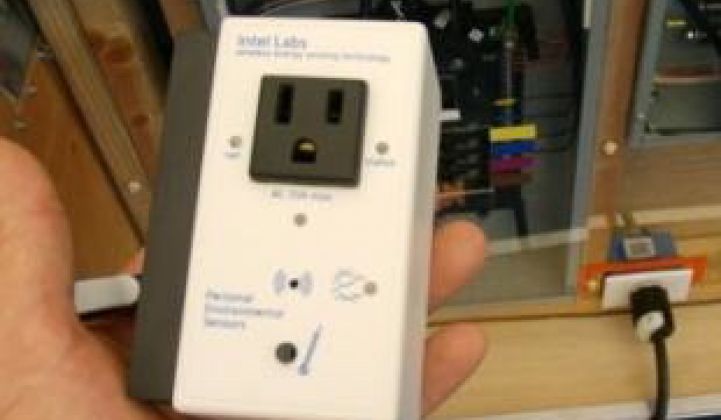Intel has a deep and broad line of work in greentech, with its technology embedded in wind turbines, microgrids, data centers and building energy controls, and home energy management systems, to name a few examples. It also has Intel Labs, where some of its far-flung science experiments sometimes find their way into mass market adoption.
One long-running Intel Labs experiment involves wireless sensors that plug into building power sockets and analyze the power to “disaggregate” power use within the building. Now Intel is taking the technology out of the lab and into the home, via the Austin, Texas-based Pecan Street Project smart grid showcase.
Intel has deployed its two-plug-per-home whole power energy sensing units in about 50 homes in the project, Lorie Wigle, general manager of Intel’s Eco-Tech Office initiative, said in a Monday interview. It's the first deployment outside the lab, though Wigle reiterated that Intel has no plans to commercialize the technology just yet.
Intel's system uses two wireless sensors that plug into ordinary power sockets. Those read the subtle changes in circuit voltage that specific appliances or home power-using systems like lights and air conditioning cause to household-wide signals. From there, these sensors can figure out when appliances or systems are turning on and off, and compare that data to overall power usage across the circuit to intuit which appliances are using power and how much.
Similar “one-plug” home-load sensing technologies are being developed by startup PowerMap and consumer electronics giant Belkin, via its acquisition of Zensi in 2010, as well as Navetas, a U.K. startup working with smart meter giant Sensus. Smart appliances, smart light bulbs, wireless plug sensors and other such energy-smart home systems can do the same thing, of course. But it would be a lot easier, and cheaper, to just plug one or two devices into any socket in the house, turn them on and start learning a home’s power profile.
The first part of Intel's Pecan Street sensor deployment is focused on making sure the technology works, Wigle said. From there, Intel and partners are interested in figuring out how to use the data coming from its sensors to engage consumers in energy efficiency and feed the utility and other interested parties useful information.
“In the research phase, you may be using a supercomputer to do all this analysis,” Wigle said of the project’s current stage. But as data rolls in and analytics engines begin to get to work figuring out which data is critical and which peripheral, and how to put data together to yield new information, “you get a lot smarter and learn what analytics could be pushed down to the home,” she said -- a nod to the importance of research to figure out how best to architect the IT connections between homeowners and utilities.
Intel has been working on home energy management technology for years, and released a hardware reference design for would-be partners in 2010. Last year it announced that French IT consulting giant Capgemini would offer customer a tablet based on Intel’s design, though the companies didn’t set a deadline for bringing the product to market. Pecan Street isn’t using Intel’s home console tech, Wigle noted.
In the longer run, Intel wants to provide consumer energy engagement insights, as well as cybersecurity and privacy protections, across the Pecan Street Project, Wigle said. The Department of Energy smart grid demonstration grant-funded project is testing out various smart grid-smart consumer technology mashups, including plug-in Chevy Volts and smart charging apps, solar panels and energy storage systems, and smart meters and home energy management devices. Partners include Sony, Whirlpool, Best Buy, General Motors and SunEdison, to name some big ones.



